ABSTRACT
Architects, civil engineers, and other specialists planning modern projects in historical centers of European cities face extremely difficult historical and spatial conditions. They also come across technical problems related to the need to save valuable heritage assets consisting of historical buildings. These problems are most pronounced in cities that have suffered significant war damage. Such cities include Gdańsk (Poland), which was almost completely destroyed during World War II. Despite the successful rebuilding of the city by the post-war generation of builders, there are still empty spaces and quarters, as well as fragments of historic frontages to be filled in the old town of Gdańsk.
This article presents several examples of modern developments designed to preserve and coexist with fragments of historic brick buildings. These building projects each faced a similar task; to save and display the historical urban fabric, but they differed significantly in how they chose to achieve that goal. Not all of the projects presented in this study meet the requirements of the Venice Charter equally well. In this field, the solution often means choosing the “lesser evil”. Each of the projects presents a unique example of interdisciplinary research used to solve complex construction problems. Numerical analysis using the finite element method (including the damage model based on plastic degradation adopted for brick walls)was carried out for one of the projects.
1. Introduction
Most large European cities have a valuable and carefully preserved historic center, where modern developments might appear from time to time. Emotional tensions evoked by such projects, both at the design and at the construction stage, reach the highest levels of creative public engagement. Designers, architects and engineers from many other industries have to face not only extremely limiting historical and spatial conditions but also technical problems involved in saving the valuable remnants of historical buildings that might be found on-site. These problems are at their most acute in cities which have suffered significant war damage. Such cities include Gdańsk, where the destruction of buildings in the city center during World War II reached almost 90% ().
Figure 1. Photograph of damage in Gdańsk after the Second World War. Source: (Cieślak and Biernat Citation1994)
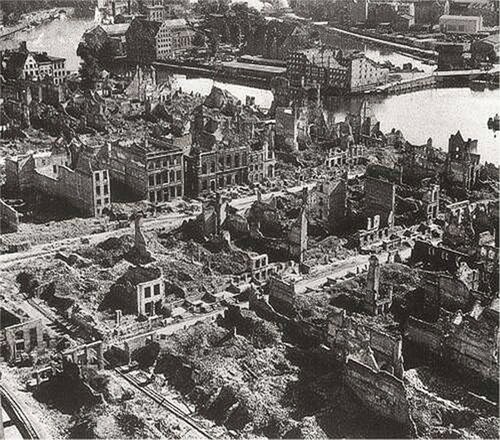
The historic center of Gdańsk was rebuilt during the post-war years. However, this reconstruction was not a faithful, literal reconstruction of the pre-war elements. Almost all significant monuments were reconstructed, the main lines of the streets were rebuilt, and the skyline was recreated, but at the same time the urban fabric was radically transformed, being adapted to the requirements of modern urban planning. A housing estate was created in the area of the historic city center. The main emphasis during the reconstruction was therefore put on housing development, which constitutes the majority of the fabric of this new — and at the same time old — urban organism (Friedrich Citation2015). Architecturally, the reconstruction of Gdańsk was a fascinating combination of modernism, socialist realism and historical heritage preservation.
Despite the successful rebuilding of the city by the post-war generation of builders, Gdańsk still needs to fill in spaces with new buildings, and replenish quarters and fragments of street frontages. However, these actions take place under different conditions than just after World War II, as they have to take into account the provisions of the Venice Charter.
This charter, adopted in 1964 by the Second International Congress of Architects and Technicians of Historical Monuments in Italy, calls for the protection and preservation of the original substance, structure and materials of historical buildings and maintaining a clear distinction between all newly added elements and the original ones. Article 9 of the Venice Charter is the most relevant here, which states: “The process of restoration is a highly specialized operation. Its aim is to preserve and reveal the aesthetic and historic value of the monument and is based on respect for original material and authentic documents. It must stop at the point where conjecture begins, and in this case moreover any extra work which is indispensable must be distinct from the architectural composition and must bear a contemporary stamp. The restoration in any case must be preceded and followed by an archaeological and historical study of the monument”, and Article 10, which states: “Where traditional techniques prove inadequate, the consolidation of a monument can be achieved by the use of any modern technique for conservation and construction, the efficacy of which has been shown by scientific data and proved by experience”.
Sometimes, however, when designing new buildings in such sensitive locations, it is better to save the historic remains in some form — contrary to the Venice Charter — than to lose them forever (Gruszkowski Citation2002).
Various ways of protecting valuable historic brick buildings are known and widely used. They can be adapted to perform a new function (e.g., Sowińska-Heim Citation2017), left exposed to view during the transformation (e.g., Giorgi and Matracchi Citation2011), fitted into a position within the new structure after brick or stone is removed and cleaned (e.g., Duffy Citation2011) or left as an original part of the new structure.
Proper structural analysis is an inherent element of contemporary architectural design. A significant change in this respect took place with the development of powerful computers. Several commercial programs for structural design as well as its static and/or dynamic analysis have been developed. Among the most popular software used by architects and civil engineers is AutoCAD (Automatic Computer Aided Design) although SketchUp has also recently become popular. Some structural analysis programs, based, among other things, on finite element codes, have also been incorporated into CAD systems. Among the many commercial programs for designing and analysing structures, it is worth mentioning REVIT, STAAD Pro, RISA, SAAP2000, ETABS, NASTRAN, ROBOT, ABAQUS and SOFISTIK (e.g., Lallotra and Singhal Citation2017; Gravit et al. Citation2018; Wakil and Sharma Citation2019). Building information modeling (BIM) is an element of best-practice design and should be incorporated into the design process from the beginning. However, although specific BIM packages exist and can perform finite element analyses for structures, they are limited to simple cases. For existing buildings, especially historical ones, this procedure proves to be impractical for a number of reasons, including the complexity of real geometry (Crespi et al. Citation2015). Structural analysis becomes more complicated when designing a new building in combination with elements of old buildings, especially if attempting to preserve existing fragments. In such cases, special attention should be paid to the analysis of the historical masonry structure. Methods applicable to the study of historical masonry structures have been reviewed in several publications (Lourenço Citation2001, Citation2002; Roca et al. Citation2010; Theodossopoulos and Sinha Citation2013). In general, such structures can be analysed based on limit analysis, distinct element methods or finite element methods, with the latter being the most often used ().
Table 1. A brief description of methods for the analysis of historical structures.
The FE method for masonry is based on two main modeling approaches: Micro-modeling and Macro-modeling (Roca et al. Citation2010). In the first case, the units and mortar are modeled as continuum elements and the unit-mortar interfaces are modeled as discontinuum elements. In the latter, the masonry is considered to be a homogeneous material with no distinction made between units and mortar. Some interesting examples of applying the finite element methods to analyse historical masonry structures are given, among others, in Lourenço Citation2002; Roca et al. Citation2010 and Giordano, Mele, and De Luca Citation2002. Recently, the damage model based on plastic degradation proposed by Lubliner et al. (Citation1989) has been increasingly used in modeling historical masonry structures (e.g., Resta, Fiore, and Monaco Citation2013; Liberatore, Addessi, and Sangirardi Citation2019; Kujawa, Lubowiecka, and Szymczak Citation2020). The authors also applied this model to analyse structures (Przewłócki, Zielińska, and Grębowski Citation2017; Grębowski, Rucka, and Wilde Citation2019), while a model based on the plastic degradation theory was used in this paper to analyse one of presented cases. A numerical analysis of masonry should take into account not only its above-ground parts, i.e., walls, pillars, ceilings and vaults, but also its foundations. Unfortunately, there are few comprehensive studies devoted to foundations of historical buildings (Kerisel Citation1975; Przewłócki, Dardzińska, and Świniański Citation2005). Most of the papers concern the diagnostics and maintenance of specific buildings, foundations, and case studies. Various aspects of the history of foundation engineering, with particular focus on its development, the techniques used, materials and stabilisation methods, are described in the latter (Przewłócki, Dardzińska, and Świniański Citation2005). A numerical analysis of stone foundations by the finite element method is given in Przewłócki and Zielińska (Citation2016).
Technical considerations are only some of the problems that must be faced in the process of saving historical heritage. Such processes are always accompanied by vigorous social debate and numerous disputes over policies and implementation methods. Despite the apparent domination of architectural considerations, it turns out that many other factors play an important role in making decisions on these projects (Mualam and Alterman Citation2020). These include the decisions of city planning authorities, conservation and social considerations, economic considerations and the real estate market. Certainly, any such projects must ensure that planners, conservators, architects, investors, and the local community are all able to work together to achieve the desired goal (Chalana Citation2016).
Cultural heritage objects, in particular monuments of architecture, are increasingly often considered to be a common heritage of mankind, motivating the search for international standards for their protection and restoration. The International Council on Monuments and Sites (ICOMOS), established in 1965, was a significant step towards establishing a common model and commonly adopted rules. The concept of authenticity preferred by ICOMOS assumes that changes to the historical fabric should be avoided as much as possible.
Despite this, in many countries (not only in Europe), preservationists have to consent to various types of, sometimes very significant, interventions in the historic fabric, such as structural reinforcements or the removal of historical remains and their replacement with new structures (Henrichsen Citation2017). It should be noted here that designers in different countries deal with these challenges in very different ways, constantly looking for new, optimal approaches to interacting with historic buildings while maintaining their authenticity. Numerous issues of contemporary architectural design in cities with historic buildings are discussed in (Lardinois Citation2017; Khalaf Citation2015; Vegas and Mileto Citation2017; Zagroba and Gawryluk Citation2017; Gatti Citation2018; Palaiologou and Fouseki Citation2018; Gentry and Smith Citation2019).
The article presents three contemporary designs involving the remains of historic brick buildings. These projects, although they solve a similar problem of saving and highlighting the historical urban fabric, differ significantly in the way they achieve that goal. The differences reflect not only spatial but also technical aspects, which makes each project presented herein an exceptional and unique example of an interdisciplinary quest for solutions to complex architectural problems. However, not all of these projects meet the requirements of the Venice Charter equally well. Therefore, two of the developments are presented briefly, showing only the most important elements of the adopted solutions, and the third one, fully complying with the requirements of the Venice Charter, is described in detail, presenting both the fundamentals of the spatial concept and the architectural, engineering and building solutions. The solutions presented in this article can therefore be useful to those involved in the preservation of historical heritage worldwide.
2. Cellar Walls in Gothic Tenement Houses on Szeroka Street, Gdańsk
A large building complex which combines a multi-family residential function and commercial function was completed to the design of the first author (Taraszkiewicz Citation2013) on Szeroka Street, in the very heart of the historical city center of Gdańsk ().
Figure 2. Plan of the historical part of Gdańsk with marked locations of the discussed developments. A – Cellar walls in Gothic tenement houses on Szeroka Street. B – Remnant of the granary on Wyspa Spichrzów. C – Granaries on Żytnia Street. Source: K. Taraszkiewicz, own materials, 2020
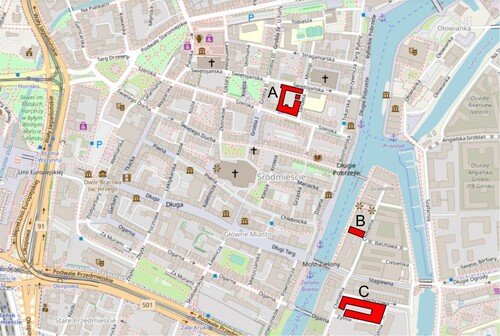
Despite its extremely prestigious location, the area, degraded by war damage, had been for decades an unpleasant “hole” in the sequence of buildings, waiting for proper use and development, commensurate with its rank in the urban structure (). Design work on the complex of new buildings took place in an atmosphere of fairly calm but important debates between the historic monument protection authorities, architects and the public. Community organisations representing the residents saw the new buildings as a reconstruction of pre-war buildings. Following the principles of the Venice Charter, due to the lack of original iconography, the conservation authorities were inclined towards a modern design, with the scale and character of the new building made to fit with the historical context of the place. The architects shared the position of the conservation authorities, and set themselves the goal of designing buildings that would respect the heritage of the past but bear witness to the time in which it was built.
Figure 3. View of the site before the construction of the block. Source: photo by A. Taraszkiewicz, 2010
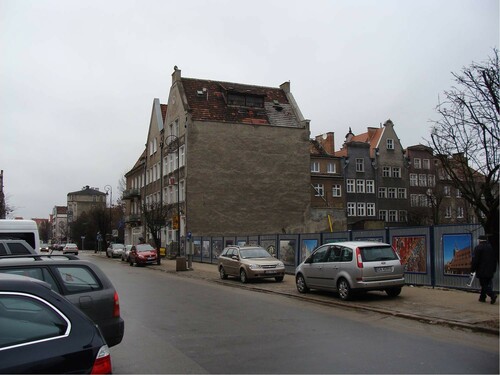
However, the architects had to take into account the preservation guidelines in their work. These guidelines determined the urban layout and scale of the newly designed buildings. The building alignment in the block, as well as the rhythm, width and height of the house fronts all follow historical lot divisions verified by archaeological findings and presented in the 1866–1869 Situations Plan von Danzig by D. Buhse (Stankiewicz Citation1959).
The design of the block refers explicitly to the historical buildings in Gdańsk, but at the same time, it is thoroughly contemporary, with historical references incorporated as neither direct transfers nor borrowings. The contemporary expression of this architecture is determined by the façade expression which is typically modern, drawing on the achievements of the international style, “fresh” architectural details (e.g., minimalist beams or lintels made of rolled c channels) and modern building materials and technologies, e.g., zinc-titanium sheet metal used as façade material ().
Figure 4. Block of buildings on Szeroka Street, Gdańsk. View after completion. Source: photo by A. Taraszkiewicz, 2012.
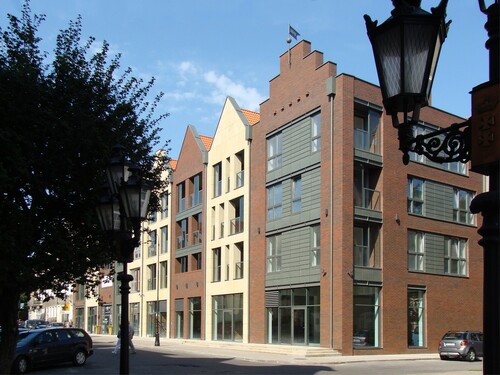
The block has a deep, two-storey underground car park due to city parking requirements. The excavation work for the car park uncovered valuable remains of Gothic brick cellar walls of the tenement houses that used to stand there (a). These historic remains, with their beautiful ogival vaulting, conflicted with the functional and technical solutions proposed in the design, thus preventing the whole project from progressing.
Figure 5. a) Fragment of Gothic brick cellar walls, b) Remnant of the Gothic wall displayed on the ground floor of the block on Szeroka Street, Gdańsk. Source: photo by A. Taraszkiewicz, 2011, 2012

The issue of saving the historic brick walls became an element of dispute and discussion between the conservation authorities and the architects. In accordance with the recommendations of the Venice Charter, the conservation authorities wanted to leave the historic walls where they had been found, i.e., underground. However, this would have made it impossible to build the underground car park necessary for the proper functioning of the modern building, so the designers believed that the historic walls should be removed from their under ground location and displayed in public view on the ground floor level.
Finally the decision was made, in consultation with the conservation authorities, to cut the walls into large four-metre pieces, enclose them within steel clamps specially designed for this purpose, take them out and move them to a military training ground for drying, mould removal and conservation. Once the reinforced concrete ceiling was built over the underground car park, the walls were returned to the site where they were reassembled and placed according to their historical orientation and position, but one and a half storeys higher, i.e., at the ground floor level. Thanks to this solution (not entirely complying with the Venice Charter), a previously unknown, valuable fragment of Gdańsk’s brick architecture was excavated and saved. Displayed to the general public on the ground floor of the new block, it makes for an attractive historical element in the modern interior design, accessible to all (b). Thus, the architecture of the block creatively combined looking into the future without forgetting about the legacy of the past.
In order to contextualise the investment in question, it is necessary to emphasise several important issues from the point of view of conservation protection: The area on which the object in question is located was covered by a local spatial development plan (which constituted an act of local law) adopted in 2003 by the Gdańsk City Council. This plan took into account conservation guidelines, but there were no direct references to the Venice Charter, and some of its provisions, such as the possibility of reconstructing buildings, were contrary to Art. 9 of Charter. Due to the lack of iconography showing the historical buildings that once existed in the area, the conservation services allowed the introduction of contemporary architecture of the buildings, focussing mainly on saving the valuable remnant in the form of excavated Gothic walls. The introduction of contemporary architecture was in accordance with Art. 9 of the Venice Charter, while the relocation of the Gothic walls (removing them from the ground and placing them on the ground floor) and their cutting and reassembly were not in accordance with Art. 9 of the Charter.
3. Remnant of the Granary on Wyspa Spichrzów, Gdańsk
Completely destroyed by the warfare of 1945, Wyspa Spichrzów (Granary Island) in Gdańsk, despite its excellent location in the city center and the numerous urban and architectural contests for its development, had been waiting for decades for a development matching its historical, cultural and urban importance. Development has begun there in recent years, so that Wyspa Spichrzów will now be able to cater to the needs and expectations of the authorities and residents of Gdańsk.
One such undertaking was the development of a residential and hotel complex known as Deo Plaza, completed in 2019. This was an attempt to construct buildings with modern architectural expression that also refer directly to the forms of the historical granaries which were once standing in the same location. Following the guidelines of the conservation authorities, the creators of the new buildings decided to also incorporate remnants of old brick buildings into the modern structure, which are a tangible testimony to medieval architecture and building arts.
Among the many ruins of granaries found in this area, one of the more interesting was the fifteenth century brick granary known as Woli Łeb (Ox’s Head). After the war, only part of the front façade survived, decorated with a stone-carved coat of arms (Ox’s Head), flags and a cartouche with the Latin inscription, “As it was the Winterfelds’ duty to their unknown successors, the monument from the ruins was raised and restored in 1759” ().
Figure 6. Ruins of the granary Woli Łeb on Wyspa Spichrzów. Source: A. Taraszkiewicz, own materials, 2020
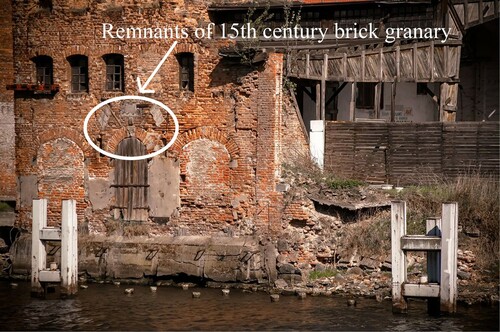
In connection with this investment, a lively discussion took place between the conservation services, architects and the public. It took place in many forums and in the media, and included Gdańsk residents and community organisations. This debate, in which the majority of engaged voices were in favor of a complete reconstruction of the historic buildings, did not meet with the approval of the conservation authorities and thus did not have a significant impact on the design decisions and the decisions of the relevant administrative bodies. From a conservation standpoint the issue of saving a preserved fragment of the façade of the Woli Łab granary was of particular importance here.
Due to its poor technical condition and weak foundations which could not bear the weight of the superstructure planned in the modern design, comparable to the original dimensions of the granary, a rather controversial decision was made to completely dismantle the historical building, a decision to a large extent contrary to the Venice Charter guidelines. Dismantled and inventoried, brick and stone elements and architectural details underwent conservation and were then rebuilt in their original location on a solid, reinforced concrete foundation. Rebuilt in this way, the façade wall could now take the weight of the contemporary five-storey glazed superstructure designed in the aluminium post and beam façade technology. The preserved coat of arms, relief with the flags and the cartouche with the inscription (a, b) were set in the axis of the façade, above the entrance on the ground floor.
Figure 7. a) Front façade of the Woli Łeb granary on Wyspa Spichrzów, Gdańsk, b) Close-up of the relief of the flags and the cartouche. Source: A. Taraszkiewicz, own materials, 2020
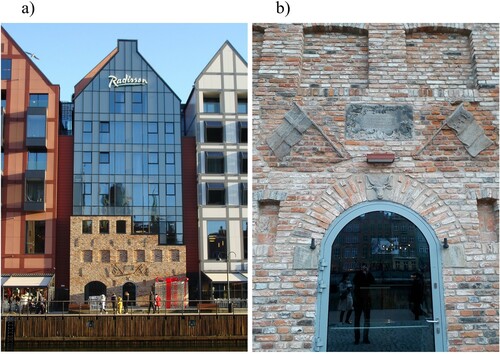
As in the previous case, the area where the object in question is located was included in the local spatial development plan. The plan dated back to 1998, was a local law act and contained, among other things, conservation guidelines. There were no direct references to the provisions of the Venice Charter in the local development plan, but the provisions of the plan did not conflict with the Charter. Due to the significant degree of deterioration of the granary, the conservation authorities allowed for the demolition of its remains, drying, fumigation and recomposition on the same site. It was then allowed to add a modern structure to replace the missing elements of the granary. The introduction of contemporary architecture was in line with the principles of Art. 9 of the Venice Charter, while the demolition and subsequent reconstruction of the historic elements of the granary, reducing the authenticity of the historic element, did not comply with the Charter. The basic strategy for the protection of cultural heritage was to preserve the historical form of the fragments of the granary and the material from which they were made. Maintaining the location of the remains was also a strategic objective. However, the aim to preserve the original, authentic structure of the monument was abandoned.
4. Granaries on Żytnia Street, Gdańsk
Żytnia Street in Gdańsk is located in the central part of Wyspa Spichrzów. All new and properly conducted developments here are extremely important for the old town of Gdańsk. One such project was a residential and hotel complex located in the block of Żytnia, Chmielna and Spichrzowa streets.
The urban layout of this complex was based (according to conservation guidelines) on historical, archaeologically verified lot divisions, and its massing’s proportions were shaped on the basis of iconographic materials showing the architecture of the granaries that once stood there. The massing of the newly designed buildings followed the “granary massing” principle, i.e., a cuboid, covered with a steep gable roof with a ridge set along the axis of the historical lot, perpendicular to the direction of the street, or with a ridge, set (according to historical evidence) parallel to the street. The planned buildings clearly refer to the historical lotting in the shape of their façades, using vertical divisions and gable walls found at the opposite ends of the ridge.
What differentiates this development from other buildings currently under construction in historical city centers is the need to incorporate the valuable surviving fragments of three granaries which remain under strict conservation protection – “Czarny Kogut” (Black Rooster), “Arka Noego” (Noah’s Ark) and “Kuźnia” (Smithy) – into the massing, and adapt them to the contemporary function (). The way this problem was solved became the main determinant of all the design efforts made in this project.
Figure 8. Remnants of the granaries on Żytnia Street. Source: photo. A. Taraszkiewicz, Citation2007
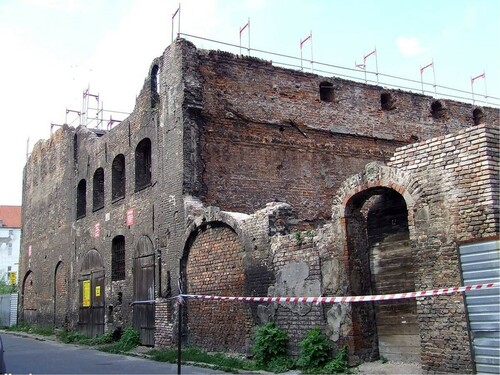
In this case, there was also a public debate on the best way to save the preserved fragments of the granaries, although it was quite calm and took place mainly through the media, involving Gdańsk residents and community organisations. This debate, which, as usual, was dominated by non-professional voices in favor of the complete restoration of historical buildings, was only partially accepted by the conservation authorities. The designers were satisfied with the conservation authority’s proposal allowing for the full preservation of the authentic historical fabric of the granaries, supplemented by contemporary elements.
In agreement with the conservation authorities, it was decided, following the Venice Charter, to completely preserve the original substance, structure and materials of the monument, and to clearly distinguish all newly added elements of the building from the original ones (Taraszkiewicz Citation2013).
The historical brick walls were to be dried, cleaned of mould and undergo conservation without complete or even partial dismantling. To avoid burdening the existing remnants of the granaries with the superstructure, reinforced concrete piles and rafter plates () were designed, placed along the walls of the granaries but at a certain distance away from them. All newly designed storeys of the building, rising above the brick remnants, were supported on this new structure. Steel trimmers were placed at the level of the foundations, between the reinforced concrete piles, to strengthen and stabilise the foundations of the granaries which had already been weakened over time.
Figure 9. Buildings in the block of Żytnia, Chmielna, Spichrzowa Streets, Gdańsk, computer visualisation. Source: FORT Taraszkiewicz Architekci Sp. z o.o., 2007
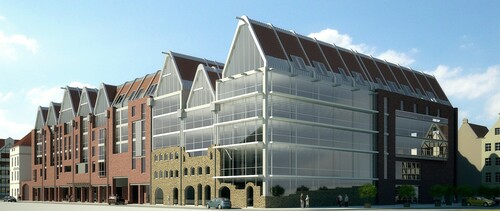
In the spirit of the Venice Charter, steps were taken to contrast the historical buildings with contemporary structures. A solution such as this, applied nowadays in many highly developed countries, even to historical buildings of the highest value (De la Torre Citation2013), seemed to be best suited to this particular case. A strong contrast between what is historical and what is contemporary makes it possible to better highlight the valuable remnants and, at the same time, by emphasising the stylistic and technological differences between the parts, makes the potential audience highly aware of the huge time span separating both parts of the building. The realisation of this fact is a fundamental prerequisite for a positive reception and acceptance of contemporary architecture located in historical surroundings. It is also necessary in the architectural quest for genius loci and in creating architecture which connects the legacy of the past with the ideas and values of the contemporary times.
Also in this case, the area where the object in question is located was covered by a local spatial development plan. This plan was a local law act, dated 1998, and took into account conservation guidelines. However, it did not include direct references to the provisions of the Venice Charter, although the provisions of the plan did not contradict the Charter. The basic conservation strategy was to completely preserve the authentic elements of the granaries and to apply technical solutions allowing for their incorporation into the new building substance. The complete preservation of the historical elements of the granaries, both in terms of their location and the authenticity of the masonry threads, and the use of modern construction techniques that make this possible, was entirely in keeping with the provisions of Art. 9 and Art. 10 of the Venice Charter.
5. Numerical Analysis
In this section, a two-step analysis of the granary wall remains on Żytnia Street in Gdańsk was carried out. First, it was checked whether these fragments were able to transfer the overburden load equivalent to that of a newly designed structure. Then, an additional foundation structure was taken into account and the stress state in the granary wall was again determined.
A numerical model of the brick granary walls was developed using the ABAQUS software in order to determine their durability (a). The analysis was conducted on a 3D model of a brick wall with dimensions of 850 × 1200 cm and a thickness equal to 120 cm. The wall was divided into 856,898 eight-node cubic solid elements of reduced integration with the linear shape function of the C3D8R type with the total number of nodes equal to 1,287,576. The calculations were carried out for several finite element mesh sizes. The greatest convergence was obtained for the mesh with a 10 mm size (ABAQUS Citation2013). The overburden load equivalent to the superstructure acting on the existing masonry wall was equal to 185 kN/m2. This load was cinematically modeled in the form of equal vertical nodes displacement in the upper element surface. The model took into account the plastic-degradation model of the brick wall with the following parameters: Young’s modulus E = 2600 MPa, Poisson’s ratio v = 0.167, density ρ = 2000kg/m3, dilatation angle Ψ = 16o, eccentricity e = 0.07, biaxial/uniaxial compression plastic strain ratio: 1.16, shape factor kc = 0.667, viscosity: 0.001, stress σc = 8.42 MPa in elastic strain ϵ = 0.009931, compressive degradation dc = 0.99 in elastic strain ϵ = 0.00931, stress σt = 0.848 MPa in crushing strain ϵc = 0.00527, tensile degradation dt = 0.97 in crushing strain ϵc = 0.00527 (FORT, Citation2007) [30]. The current condition of the brick element was also taken into account by reducing the longitudinal modulus of the elasticity value of the brick. The results obtained during the numerical analysis are presented in b in the form of stress maps. It can be seen in this figure that the existing wall fragments are unable to transfer the load of the design’s superstructure.
Figure 10. a) Numerical model of the brick wall, b) Compression stresses map of brick walls. Source: K. Grębowski, own study, 2020
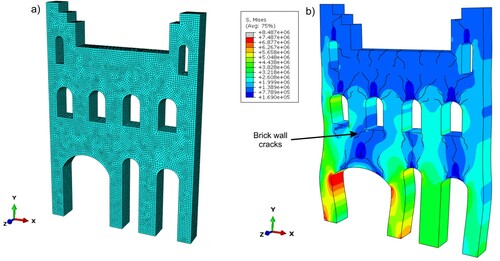
In the Middle Ages, the brick walls of buildings were often erected directly on the ground, without any foundations (Przewłócki, Dardzińska, and Świniański Citation2005). This is how the granaries on Żytnia Street in Gdańsk were constructed. Based on the obtained results, it was found that the maximum compressive stress σmax = 8.42 MPa exceeded the limit of σc = 8.12 MPa, which led to exceeding the ultimate limit state. Compressive stresses resulted in cracks in the wall structure and ultimately its total failure. As a result of the cracks and weakening of the structure, the maximum vertical displacement umax = 12.5 cm exceeded the limit value equal to ugr = 2.1 cm, which resulted in exceeding the serviceability limit state (b).
With regard to the obtained results, it was concluded that the planned superstructure of the newly designed development cannot in any way be based on the medieval wall (ABAQUS Citation2013). A reinforcement in the form of a supplementary foundation structure was designed in order to avoid applying load to the existing granary remains (a). The brick wall was based on a wide reinforced concrete foundation in the form of a pile cap which itself was based on foundation piles. A steel beam of IPE 300 section was designed to be fitted between the wall and the piles on the pile cap level in order to equally transfer the load to each pair of reinforced concrete piles (b). All of the newly designed building storeys at a distance from the brick wall were based on the pile cap structure.
Figure 11. a) Numerical model of the brick wall with the supplementary foundation structure, b) Diagram of the brick wall reinforcement, c) Compression stresses map of brick walls

The numerical model of the brick wall with the reinforcement was performed similarly to the model of the wall without the reinforcement. The initial model was updated with the elements of the supplementary foundation structure. The load was applied to the reinforced concrete pile cap in place of the newly designed building walls setting. The results obtained during the numerical analysis in the form of stress maps are presented in c.
A significant horizontal line of stress concentration is visible on the stress map in the place where the new wall is based on the pile cap. As a result, no other stress aside from the dead-load is acting on the brick wall of the granary remains. On the basis of the obtained results, it was concluded that applying the supplementary foundation structure will be safe by basing the walls of the newly designed building on the reinforced concrete pile cap without any interference with the medieval brick structure. The requirements of the ultimate limit state and the serviceability limit state were fully met.
6. Conclusions
The design and construction of contemporary architectural structures set in a historical environment and sometimes in direct contact with historical buildings or even incorporating historic remains into a new structure is extremely difficult and involves the highest levels of creative commitment and professionalism from the designers. In this type of design process, apart from performing standard activities typical of their profession, the designers have to meet the requirements related to conservation, including the guidelines resulting from archaeological research and the requirements of the Venice Charter that are often very difficult to meet. It should be added here that due to the large variety and different value of monuments, any such project is completely new and the choice of spatial and technical approaches used must always result from the unique character of the monument.
The examples presented in the article show that the design of new buildings in the context of historic remains is possible, although it requires a non-standard approach during the preparatory works and the construction phase. This non-standard approach results from the need to use modern construction methods and techniques which are different to both current standard construction methods and traditional techniques. Due to the variety of cases, their different historical and cultural value and the differences in damage and deterioration, the solutions required are always non-standard, often unique, and only applicable in this particular case.
The described solutions represent entirely different design concepts. Although the first two may raise some preservation concerns, from a practical point of view their application seems justified in the conditions under consideration. In the case of the investments on Szeroka street, especially valuable Gothic walls hidden underground for centuries have been rescued and exposed to the public, while a new complex of buildings has been created that suits the context of the site. In the case of the Woli Łeb granary on Granary Island, the historical form of the fragments of the granary and the material from which it was made were saved from disappearance and the historical location of the object was preserved. Transformed in this way, the historic granary is a new value that fits in well with the historic surroundings.
In the third of the discussed projects, all decisions were aimed at preserving the historical tissue intact, in accordance with the provisions of the Venice Charter, while striving to achieve the strongest possible contrast between the historical and the contemporary. The original form, authentic structure and historical location of the granary fragments were fully preserved, while it was possible to construct a new complex of buildings respecting the historical context of the site.
To sum up, it should be stated that in the process of creating contemporary projects embedded in a historical context, different, sometimes difficult and controversial decisions must always be made, not always in accordance with the provisions of the Venice Charter. Every time, however, it is the designer’s duty to ensure a well-thought-out coexistence of the new architectural form with the historical substance, to respect the existing values and to preserve their authenticity, which in turn is a condition for maintaining the cultural continuity of the urbanised space.
A summary of our analysis is presented in , comparing the construction solutions presented in the article in terms of: the existence of local planning legislation, references to the Venice Charter included in the planning legislation, the influence of the conservation authorities, the compliance of conservation decisions with the provisions of the Venice Charter, the scope and impact of public debate, the adopted strategy for the protection of heritage and the results achieved.
Table 2. Comparative analysis of the three cases discussed.
Disclosure Statement
No potential conflict of interest was reported by the author(s).
Additional information
Notes on contributors
A. Taraszkiewicz
A. Taraszkiewicz - Prof. PhD. Eng. of Gdansk University of Technology, Faculty of Architecture, Department of Housing and Architecture of Public Buildings.
K. Grębowski
K. Grębowski - PhD. Eng. of Gdansk University of Technology, Faculty of Architecture, Department of Technical Fundamentals of Architectural Design.
K. Taraszkiewicz
K. Taraszkiewicz - Msc. Eng. of Gdansk University of Technology, Faculty of Architecture, Department of Housing and Architecture of Public Buildings.
J. Przewłócki
J. Przewłócki - Prof. PhD. Eng. of Gdansk University of Technology, Faculty of Architecture, Department of Technical Fundamentals of Architectural Design.
References
- ABAQUS, 2013. Simulia Manuals - Material Models, ver. 6.13, ABAQUS Inc.
- Chalana, Manish. 2016. “Balancing History and Development in Seattle’s Pike/Pine Neighborhood Conservation District.” Journal of the American Planning Association 82 (2): 182–184. doi:https://doi.org/10.1080/01944363.2015.1136566.
- Cieślak, Edmund, and Czesław Biernat. 1994. Dzieje Gdańska [The History of Gdańsk], Wydawnictwo Morskie, Gdańsk, Poland.
- Crespi, Pietro, A. Franchi, Paola Ronca, Nicola Giordano, Manuela A. Scamardo, G. Gusmeroli, and G. Schiantarelli. 2015. “WIT Transactions on The Built Environment.” WIT Transactions on The Built Environment 1: 581–592. doi:https://doi.org/10.2495/BIM150471.
- De la Torre, Marta. 2013. “Values and Heritage Conservation.” Heritage &Society 60 (2): 155–166.
- Duffy, Fintan. 2011. “Can Continuity Survive the Transformative Process in Interventions on Historic Structures? The Importance of Craft as an Aspect of Continuity.” Conservation/Transformation, EAAE Transactions on Architectural Education 52: 229–238.
- Friedrich, Jacek. 2015. Odbudowa Głównego Miasta w Gdańsku w latach 1945–1960 [Reconstruction of the Main Town in Gdańsk in the Years 1945–1960], Wydawnictwo Słowo, Gdańsk, Poland.
- Gatti, Maria Paola. 2018. “Maintenance, Reconstruction and Prevention for the Regeneration of Historic Towns and Centers.” International Journal of Disaster Resilience in the Built Environment 9 (1): 96–111. doi:https://doi.org/10.1108/IJDRBE-10-2016-0043.
- Gentry, Kynan, and Laurajane Smith. 2019. “Critical Heritage Studies and the Legacies of the Late-Twentieth Century Heritage Canon.” International Journal of Heritage Studies 25 (11): 1148–1168. doi:https://doi.org/10.1080/13527258.2019.1570964.
- Giordano, Antonio, Elena Mele, and Antonello De Luca. 2002. “Modelling of Historical Masonry Structures: Comparison of Different Approaches Through a Case Study.” Engineering Structures 24: 1057–1069.
- Giorgi, Luca, and Pietro, Matracchi. 2011. “New Additions and Their Physical Relation with the Existing Building.” Transformation, EAAE Transactions on Architectural Education 52: 291–309.
- Gravit, M.V., Terekh M.D., Lyulikov V.A., and Svintsov S.A. 2018. “Software Packages for Calculation of Fire Resistance of Building Construction, Including Fire Protection.” IOP Conf. Ser.: Mater. Sci. Eng 456: 012016.
- Grębowski, Karol, Magdalena Rucka, and Krzysztof Wilde. 2019. “Non-Destructive Testing of a Sport Tribune Under Synchronized Crowd-Induced Excitation Using Vibration Analysis.” Materials 12 (13): 1–19.
- Gruszkowski, Wiesław. 2002. Miasto historyczne w dialogu ze współczesnością Evaluation of Gdańsk Wilhelm architecture during the century [The historical city in dialogue with the present], Nadbałtyckie Centrum Kultury, Faculty of Architecture, Gdańsk University of Technology.
- Henrichsen, Christoph. 2017. “Authenticity in Japan.” In Authenticity in Architectural Heritage Conservation, edited by Wieler, and Gutschow, 261–288. Cham: Springer.
- Kerisel, Jean. 1975. “Old Structures in Relation to Soil Conditions.” Géotechnique 25: 433–483.
- Khalaf, Roha W. 2015. “The Reconciliation of Heritage Conservation and Development: The Success of Criteria in Guiding the Design and Assessment of Contemporary Interventions in Historic Places.” International Journal of Architectural Research: ArchNet-IJAR 9 (1): 77–92. doi:https://doi.org/10.26687/archnet-ijar.v9i1.504.
- Kujawa, Marcin, Izabela Lubowiecka, and Czesław Szymczak. 2020. “Finite Element Modelling of a Historic Church Structure in the Context of a Masonry Damage Analysis.” Engineering Failure Analysis 107: 104233.
- Lallotra, Balwinder, and Dhirendra Singhal. 2017. “A Comptability Study on Design and Analysis of Reinforced Concrete Structural Design Using Software.” International Journal of Engineering and Technology 2: 1012–1021.
- Lardinois, Sara. 2017. “Contemporary Architecture in the Historic Environment: Recent International Perspectives.” Change Over Time 7, 252–271. doi:https://doi.org/10.1353/cot.2017.0014.
- Liberatore, Domenico, Daniela Addessi, and Marialuigia Sangirardi. 2019. “Nonlinear Analysis of Masonry Walls Based on a Damage-Plastic Formulation.” Structural Analysis of Historical Constructions 18: 1009–1017.
- Lourenço, Paulo B. 2001. “Analysis of Historical Constructions: From Thrust-Lines to Advanced Simulations.” In Historical Constructions, edited by P. B. Lourenço, and P. Roca, 91–116. Procedia Engineering. Guimarães.
- Lourenço, Paulo B. 2002. “Computations on Historic Masonry Structures.” Progress in Structural Engineering and Materials 4/3: 301–309.
- Lubliner, Jacob, Javier Oliver, Sergio Oller, and Eugenio Oñate. 1989. “A Plastic-Damage Model for Concrete.” International Journal of Solids and Structures 3: 299–326.
- Mualam, Nir Y., and Rachelle Alterman. 2020. “Architecture is Not Everything: A Multi-Faceted Conceptual Framework for Evaluating Heritage Protection Policies and Disputes.” International Journal of Cultural Policy 26 (3): 291–311.
- Palaiologou, Garyfalia, and Kalliopi Fouseki. 2018. “New Perspectives in Urban Heritage - Theory, Policy and Practice.” The Historic Environment: Policy & Practice 9 (3–4): 175–179. doi:https://doi.org/10.1080/17567505.2018.1525949.
- Przewłócki, Jarosław, Ilona Dardzińska, and Jerzy Świniański. 2005. “Review of Historical Buildings’ Foundations.” Géotechnique 55: 363–372.
- Przewłócki, Jarosław, and Monika Zielińska. 2016. “Analysis of the Behavior of Foundations of Historical Buildings.” Procedia Engineering 161: 362–367.
- Przewłócki, Jarosław, Monika Zielińska, and Karol Grębowski. 2017. “Numerical Modelling of Connections Between Stones in Foundations of Historical Buildings.” WMESS, IOP Conf. Series, Earth and Environmental Science 95: 1–8.
- Resta, Marco, Alessandra Fiore, and Pietro Monaco. 2013. “Non-Linear Finite Element Analysis of Masonry Towers by Adopting the Damage Plasticity Constitutive Model.” Advances in Structural Engineering 16 (5): 791–803.
- Roca, Piere, Miguel Cervera, Giuseppe Gariup, and Luca Pela. 2010. “Structural Analysis of Masonry Historical Constructions. Classical and Advanced Approaches.” Archives of Computational Methods in Engineering 17: 299–325.
- Sowińska-Heim, Julia. 2017. “Adaptation of Post-Industrial Architectural Heritage to new Cultural Functions: The Examples of Genk and Łódź. Conservation Adaptation.” EAAE Transactions on Architectural Education 65: 293–304.
- Stankiewicz, Jerzy. 1959. “Uwagi o odbudowie zespołu zabytkowego Gdańska” [“Comments on the Reconstruction of the Historic Gdańsk Complex”].” Ochrona Zabytków R.XII: 3–4.
- Taraszkiewicz, Antoni, FORT Architekci Sp. z o.o. 2007. Projekt budowlany “Nowy spichlerz“ [Building Project “New granary”], Gdańsk, Poland.
- Taraszkiewicz, Antoni. 2013. Research by design w architekturze [Research by design in architecture], Wydawnictwo Politechniki Gdańskiej, Gdańsk, Poland.
- Theodossopoulos, Dimitris, and Braj Sinha. 2013. “A Review of Analytical Methods in the Current Design Processes and Assessment of Performance of Masonry Structures.” Construction and Building Materials 41: 990–1001.
- Vegas, Fernando, and Camilla Mileto. 2017. “Contemporary Architecture in Dialogue with the Historic City.” Change Over Time 7 (2): 290–306. doi:https://doi.org/10.1353/cot.2017.0016.
- Wakil, Sheikh M., and Arabinda Sharma. 2019. “Development and Validation of a Finite Element Programme for Determining Stress and Displacement in Truss.” International Journal for Research in Applied Science & Engineering Technology 7 (8): 811–822.
- Zagroba, Marek, and Dorota Gawryluk. 2017. “Construction of Architectural Structures in Cultural Heritage Protection Zones.” IOP Conference Series: Materials Science and Engineering 245 (5). doi:https://doi.org/10.1088/1757-899X/245/5/052076.
